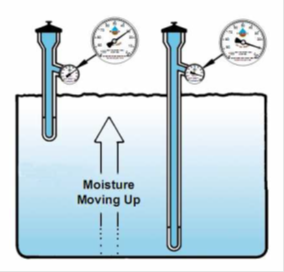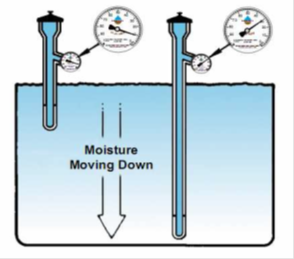Main functions | 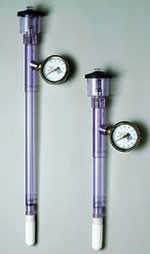 | ||||||||
| Used to measure soil water potential, suitable for field soil and places with less tension (0-1 bar).The standard configuration includes a negative pressure gauge header, which can directly display the soil tension.The 2725 injection tensile meter uses patented technology to inject water storage pipes, which is easy to use in a button type and has very little disturbance to the soil.The unique modular structure makes the replacement of porous ceramic heads, dial gauge and extension tube very convenient and lively.Deep soil drilling installation can be carried out in combination with the 0240 series installation tools. | |||||||||
| Application areas | |||||||||
ComeHelp you decide when to start and end irrigation ComeDuring the screening of dominant species, precisely control the moisture status of plant growth ComeEstablish the relationship between plant physiological processes and changes in surrounding soil environmental moisture values ComeDetermine the soil water potential to judge the flow of groundwater | |||||||||
| Main technical parameters | |||||||||
ComeMeasurement range: 0~-1 Bar Come2725ARL06 Injection tension gauge: 15 cm long Come2725ARL12 Injection Tension Meter: 30 cm long Come2725ARL18 Injection Tension Meter: Length 46 cm Come2725ARL24 Injection Tension Meter: Length 61 cm Come2725ARL36 Injection tension gauge: 91 cm long Come2725ARL48 Injection tension gauge: 122 cm long Come2725ARL60 Injection Tension Meter: Length 152 cm | |||||||||
| How to convert the readings of the tensile meter into useful information? | |||||||||
Zero: A zero reading on the dial indicates that the moisture in nearby soil has been completely saturated, regardless of the type of soil.After heavy rainfall or heavy irrigation, the tension meter may appear as zero.If the zero value persists for a long time, the roots of the surface plant will be severely hypoxia and will have a very big impact on its growth.The continuous zero value after irrigation indicates that the soil's seepage is very poor, and the reasons need to be investigated and adjusted. | 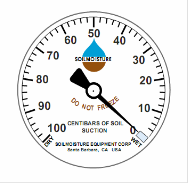 | ||||||||
| 0-10 CB: Dial readings are 0-10 cb indicating that the moisture in the soil is already overflowing for plant growth, and the moisture retained by the soil in this range will gradually be exhausted within a few days.The readings long-term in this range indicate that the soil drainage is poor, and for the normal growth of plants, it is necessary to improve the soil drainage. | 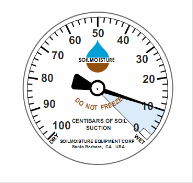 | ||||||||
10-20 Cyba: The dial reads 10-20 cb means that no matter what type of soil, there is sufficient moisture and air in the soil for healthy growth of plants.Within this range, it is most related to the "maximum water holding in the field" of the soil, indicating that the soil has reached the "maximum" ability to provide water for plants to utilize, and no matter how much moisture there is, the plants can no longer be used.After reaching the maximum water holding capacity in the field, the excess water has been discharged within one or two days through other methods before it can be absorbed and utilized by the plant roots.If the reading of the tension meter is again ranged, the ongoing irrigation should be stopped immediately.Because too much water will be discharged through the rhizosphere, which not only wastes water but also takes away precious fertilizer. Heavy clay: no irrigation is required at this time; Loam: No irrigation is required at this time; Sand: No irrigation is required at this time; but due to the limited capacity of sandy soil to store water, the soil's suction will increase rapidly as the plants utilize water. Rised to 15-20 centiba.If it is a plant that is very sensitive to moisture, such as tomatoes, grow on coarse sandy soil, the reading is 15-20 Irrigation should be carried out during the centiba to avoid the delay in irrigation causing long-term stress and causing harm to the growth of plants. | 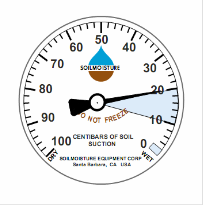 | ||||||||
20-40 Cyba: Effective moisture and porosity are ideal for plant growth. | 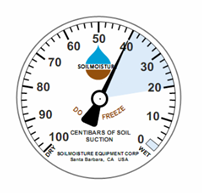 | ||||||||
40-60 centiba: Effective moisture and porosity in fine soils are suitable for plant growth. Heavy clay: no irrigation is required at this time; Loam: Irrigation needs to be started within this range. The finer the soil texture, the higher the reading before irrigation begins. Sand: The soil is too dry.High temperature and strong winds will cause the soil to quickly increase suction and damage plants. | 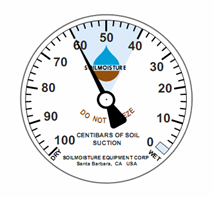 | ||||||||
60-80 Cyba: Except in heavy clay, other types of soils lack effective moisture. Heavy clay: Irrigation must be carried out when the soil suction reaches 70-80 centiba; Loam: The soil is too dry.High temperature and strong winds will cause the soil to quickly increase suction and damage plants. Sand: The soil is too dry and the plants have been seriously damaged before irrigation can be carried out. | 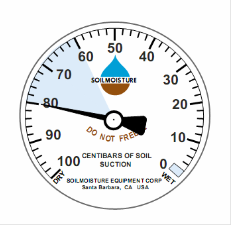 | ||||||||
Tension meter readings at different depths reveal the direction of movement of moisture in soil profile | |||||||||
Figure 1: Soil moisture moves upward. |
Figure 2: Soil moisture moves downward. | ||||||||
| Origin:Soilmoisture Equipment Corp | |||||||||
